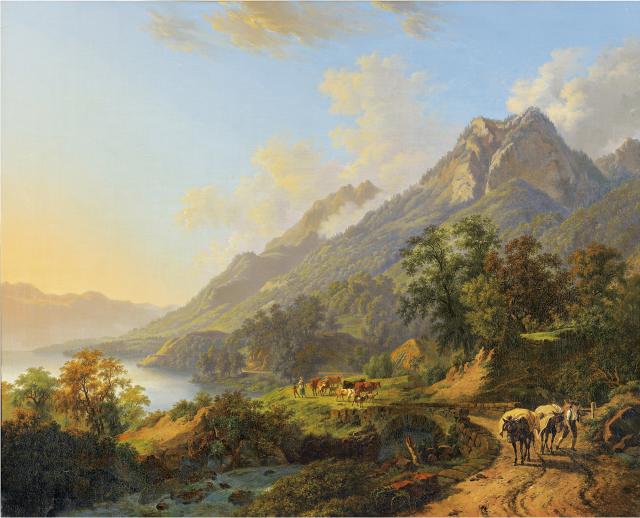Deemed “one of [his] best pictures” by the painter himself, Vue de l’extrémité orientale du lac Léman avec la nouvelle route du Simplon au pied des montagnes de Saint-Gingolph (View of the Eastern End of Lake Geneva with the New Simplon Route at the Foot of the Saint-Gingolph Mountains) is painted in 1812 by Pierre-Louis De la Rive. The work dates from the artist’s mature period and is enthusiastically snapped up by the banker Jean-Gabriel Eynard for thirty louis.
As De la Rive sees it, all landscapes must be perfectly composed and balanced. The lines laid out on the canvas therefore express his idea of classic beauty and tend to represent a nature that is “more beautiful than reality”. The Saint-Gingolph painting offers us a serene composition that is given a dynamic vitality by the outlines of two peaks, the Dent d’Oche and the Grammont, which form a diagonal dividing the canvas in two.
The Genevan painter is very much attached to the local landscape and ranges over the countryside first before returning with numerous sketches that allow him to construct an idealised painting in the studio. This picture makes clear De la Rive’s knowledge of nature and high regard for observation, notably in the jagged line of the trees” foliage that echoes the bouquets of clouds floating in the blue of the sky. A warm glow emanates from the left of the landscape, testifying to the store of light the painter accumulated during his stay in Italy from 1784 to 1786.
He wrote, “Crossing the Apennines showed me a completely new nature, forms that were gentler than the landscape of my country… hues that were lighter, contrasts that were less stark…” His discovery of the south enabled him to transform with virtuosity Genevan landscapes into a dream Arcadia.
“ Saint-Gingolph sparks family enthusiasm when it arrives in April, 1814, at the château of Beaulieu-sur-Rolle. In the absence ofEynard, the secretary of the Genevan legation to the Congress of Paris (which was headed by his uncle Charles Pictet de Rochemont), Anna Eynard-Lullin, the sister of Adolphe Lullin and the wife of Jean-Gabriel since 1810, had personally arranged for the transportation of the canvases to Rolle by the Genevan haulier Julliard; she relates the event to her husband : “This morning we unpacked the paintings, which arrived in perfect condition. Beaumont [Jacob de Beaumont, Anna Eynard’s brother-in-law] and [Jacques] Eynard were in utter admiration before the two de la Rives. Beaumont said, "The day M. de la Rive dies Saint Gingolphe will be worth 6000 f.; " the one by M. Toeppfer [not located] greatly loses out when viewed next to the former two. It’s dull but is pretty with details, it is graceful […]."” (Excerpt from a monograph by P.-A. Guerreta, p. 457).
As De la Rive sees it, all landscapes must be perfectly composed and balanced. The lines laid out on the canvas therefore express his idea of classic beauty and tend to represent a nature that is “more beautiful than reality”. The Saint-Gingolph painting offers us a serene composition that is given a dynamic vitality by the outlines of two peaks, the Dent d’Oche and the Grammont, which form a diagonal dividing the canvas in two.
The Genevan painter is very much attached to the local landscape and ranges over the countryside first before returning with numerous sketches that allow him to construct an idealised painting in the studio. This picture makes clear De la Rive’s knowledge of nature and high regard for observation, notably in the jagged line of the trees” foliage that echoes the bouquets of clouds floating in the blue of the sky. A warm glow emanates from the left of the landscape, testifying to the store of light the painter accumulated during his stay in Italy from 1784 to 1786.
He wrote, “Crossing the Apennines showed me a completely new nature, forms that were gentler than the landscape of my country… hues that were lighter, contrasts that were less stark…” His discovery of the south enabled him to transform with virtuosity Genevan landscapes into a dream Arcadia.
“ Saint-Gingolph sparks family enthusiasm when it arrives in April, 1814, at the château of Beaulieu-sur-Rolle. In the absence ofEynard, the secretary of the Genevan legation to the Congress of Paris (which was headed by his uncle Charles Pictet de Rochemont), Anna Eynard-Lullin, the sister of Adolphe Lullin and the wife of Jean-Gabriel since 1810, had personally arranged for the transportation of the canvases to Rolle by the Genevan haulier Julliard; she relates the event to her husband : “This morning we unpacked the paintings, which arrived in perfect condition. Beaumont [Jacob de Beaumont, Anna Eynard’s brother-in-law] and [Jacques] Eynard were in utter admiration before the two de la Rives. Beaumont said, "The day M. de la Rive dies Saint Gingolphe will be worth 6000 f.; " the one by M. Toeppfer [not located] greatly loses out when viewed next to the former two. It’s dull but is pretty with details, it is graceful […]."” (Excerpt from a monograph by P.-A. Guerreta, p. 457).
